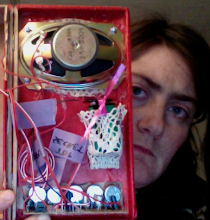I recevied some feedback from Stuart Nolan suggesting that we might consider giving something back to the users, maybe by placing a file back on their USB device after we erase their photo files, some kind of receipt or visualization for the images that have been disposed of. Or maybe a 'certificate of safe image disposal".
Regarding the audio, AGF created a few sound clips, some more electronic noises and some using words. The groups comments were to suggest that we keep away from recognizable words since they would be uni-lingual. But maybe it can be nice to use voice to create more abstract sounds that still reference an intimate conversation between the user and the unit.
I just had a nice conversation with Manuel a cultural journalist from the national TV. He said he liked the idea of having a place to dump photos, not only to feel like he was putting a quantity of photos away in a safe manner but also because it is an opportunity to release very meaningful images that he did not know how to release without some kind of ceremonial closure. He said maybe this rainbow machine could be the right way to finally let go of all his photos of his ex-girlfriend. I haven't thought about the memory value of the images for a long time. This was one of the beginning inspirations for the NJP (New Japanese Paparazzi) and also the Rainbows project but lately I have just been thinking about concerns for digital data piling up in some kind of threatening virtual garbage dump. I am so grateful to be reminded of this more poetic and emotional aspect of the project.
Today Daniel and I planned out the week and he started to clean the crank and mount in onto the frame. I went out for another intense supply finding session and came back with the GOLD!
 I found this prism in the very back of some huge open air medical market that sells microscopes, lab glass and the kind of surgical tools that you could steal someone's kidney with. I somehow managed to explain myself and speak some decent spanish and everyone I spoke to was really helpful. It is really hard to photograph a prism! I was trying to get a nice image and the camera kept going out of focus!
I found this prism in the very back of some huge open air medical market that sells microscopes, lab glass and the kind of surgical tools that you could steal someone's kidney with. I somehow managed to explain myself and speak some decent spanish and everyone I spoke to was really helpful. It is really hard to photograph a prism! I was trying to get a nice image and the camera kept going out of focus!
got some locking wheels. We're mobile now!

Now the crank is clean, users will not get their hands greasy. Dan also mounted a handle onto the crank to make easier turning and cut the metal bars shorter so that we can bolt everything onto the unit.

Jimmy and Dan varnished the unit. We have to make sure everything is properly water proofed because we're using water and also because its extremely humid in Lima and all the wood could warp.

I found these great hose connectors that branch from large to very small tubing. The man that sold them to me was the one that directed me to the dark place where I found the prism.

So I used the nice connectors to create an in-line electronic valve that will open and close the waterflow. It will be triggered through the Arduino to make the mini-rainfall. Frank said we'll have to be careful with this valve because it draws a lot of current and it will suck all the juice out of our battery.... does this mean very short rainbows?
About the battery... I hope that we can make the project entirely battery powered. In this instance, this means that someone(a gallery attendant) will have the charge the battery, maybe daily. I really want the unit to be stand alone, ie, no power cables coming from it. Someone this is more magical... but we will see... because if it has to be change electrically every night, then its a bit silly to have a battery. Eventually the project will be solar powered and show be a 100% closed system, regarding the power. I am also looking into dynamo power. Since users will turn the crank, we could include a dynamo and generate some power that way.
One other think regarding release is that using this manual pump, in which the pressure is held int he same bottle as the water (the only bottle) we cannot put the water back into the bottle. There is no intake opening. We will plant grass inside the unit, under the rain, but depending on how many people visit the project and make rainbows, we will maybe need a spout to release the water. Maybe it will just be a spout that pours out onto the ground or into a bucket... I'm not sure yet. And this also means that a gallery attendant will have to fill the bottle sometimes and maybe pump up the pressure on occasion as this is also dependent on the number of users and photos imputted.
I think we have nearly all the supplies now and we have a lot of aspects to deal with but we're advancing well. Steve Helsing is coming to Lima in a couple days to collaborate and Maxime Damecour is arriving on the 25th.

No comments:
Post a Comment